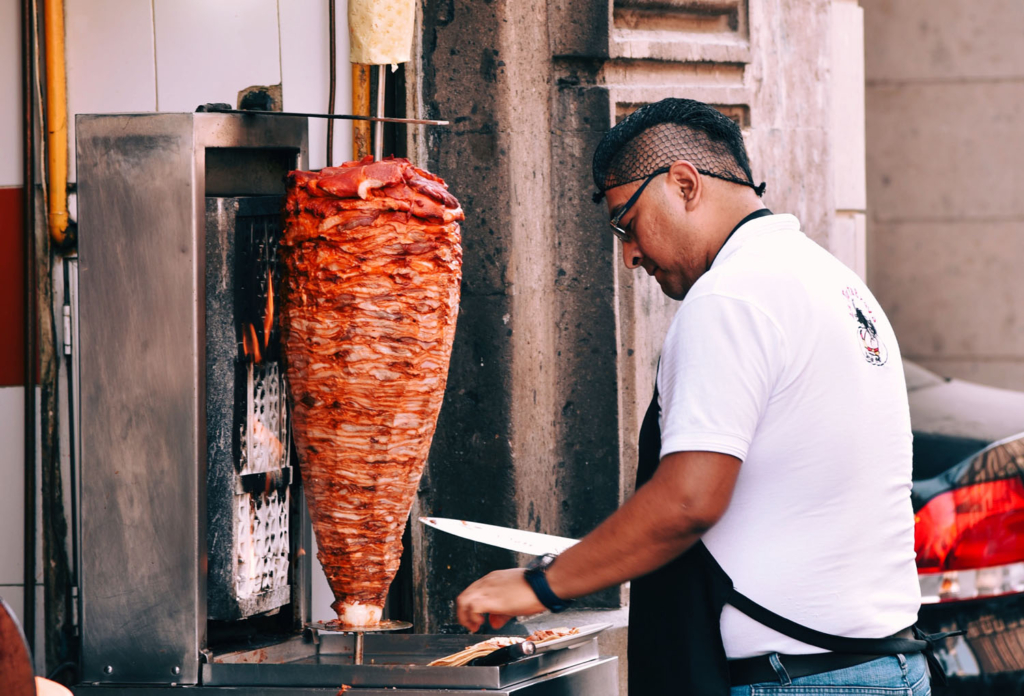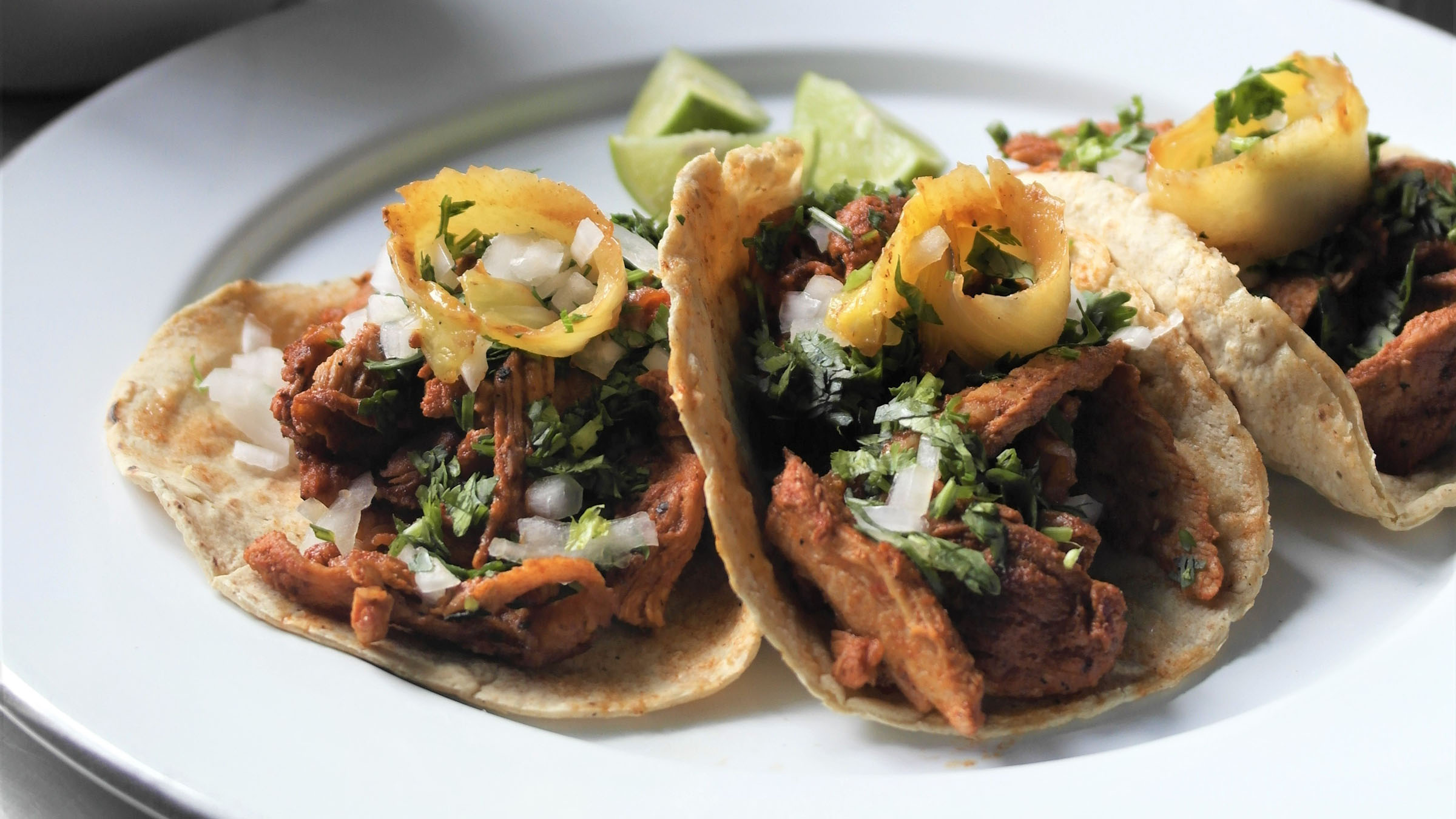If one were to bestow the title of “King of Mexico City Late-Night Cuisine”, tacos al pastor would surely wear the crown. These succulent, palm-sized tacos served on virtually every corner are arguably the best and most popular option among locals for a filling dinner or a midnight snack.
The Specialty
Over-lit taquerias across the city generally have no need to announce the inclusion of this favourite on their menu – the sight of a trompo behind the counter says it all. Slowly spinning on a spit, a trompo is a tantalising stack of seasoned pork slices layered tightly, appearing wider at the top and narrower at the bottom. Meaning “top”, trompo gets its moniker from this iconic shape resembling the childrens’ toy of the same name.

The extra-juicy and perfectly seared meat is usually pork shoulder that has been marinated in a mix of chillies, vinegar, herbs and spices like cumin, allspice, bay leaves and achiote (annatto seed, which lends the meat its characteristic reddish hue). Technically, the addition of vinegar makes this an adobo sauce, and as you can imagine, recipes may vary from one taqueria to another. How a taco shop seasons their trompo, as well as what salsa recipe they use, is one of the key factors that can make or break a place in the taco business.
The vertical upright grill is of course a vital part of the equation, slowly cooking the meat as it rotates in order to crisp the outer layer right before it is sliced. Most taquerias have a gas burner, but if you’re lucky, you may be able to find one that uses charcoal or wood, which provides an extra depth of smoky flavour. You may also bump into a trompo that features a fresh, peeled pineapple at the top or whole onions at the bottom – or even both.
Watching a taquero work on an al pastor spit is sure to instil wonder and amazement. You’ll see the skilled expert shaving thin slices of the meat with one hand, and masterfully laying it on a warm corn tortilla held in the other. Then, with a quick movement of the very sharp knife, they flick a small piece of the pineapple that almost miraculously falls right onto the taco, which is finished off with freshly chopped cilantro and white onions.
The late-night delicacy is not ready to be enjoyed, however, until you’ve squeezed the juice of a lime on top, sprinkled a bit of salt and soaked the taco in the salsa of your choice. For best results, pinch the taco with three fingers on one side and the thumb on the other, and lean in with your head slightly bent sideways rather than tipping the taco, so the meat and fillings won’t end up on your plate.
Repeat the process as many times as needed until fully satisfied.
The History
The taco of choice for chilangos (the slang term for the people of Mexico City) traces its origins two and a half hours outside of Mexico City in Puebla, also known as the City of Angels and the birthplace of other Mexican food staples such as chiles en nogada, mole poblano and cemitas, among others.
It also happens to be one of the destinations of choice for Lebanese people who immigrated to Mexico in the late 19th and early 20th centuries, bringing along with them one of their classic dishes, shawarma, which led to the creation of a magnificent fusion food: tacos árabes or “Arab tacos”.
Although the meat was eventually changed from lamb to pork – due to its wide availability and the lack of local religious dietary restrictions against pork – the principle remained the same: layered meat roasted on a spit, shaved and then laid on warm pita bread. Sometimes even served with a smudge of jocoque, a yogurt-like dressing that’s very similar to labneh, as well as a smoky chipotle and tomato-based salsa – a fantastic melding of two cultures on a plate.

This comforting snack eventually made its way to the country’s capital, where the pita bread was swapped for a small corn tortilla known as a taquera, the meat was soaked first in a flavourful seasoning of local spices, and a tangy addition was made in the form of a pineapple slice. Tacos al pastor were finally born.
The Variations
Once you’re a member of the al pastor fanbase, you may want to start looking into the many different versions and possibilities out there.
Beginning with the two main types of possible garnishes: you’ll either find a trompo with a pineapple on top, which will normally be fresh and tangy (not grilled) so as to add an extra citrusy note to the taco, or you’ll find an iteration without the tropical fruit, offering instead a mountain of deliciously caramelised chopped onions. Whether you prefer one or the other tends to be a very important statement, so choose wisely.
Then come the dishes made with al pastor meat, starting with the gringa, which is sometimes known in the USA as a quesadilla; in between two flour tortillas reside a few layers of freshly shaven meat and a very rich portion of cheese, making for a toasty, messy, juicy and sumptuous meal.
If you are still not fully satisfied, you can always go for one of the heartiest options available, the torta de pastor: with the juicy meat served inside a slightly toasted, thin crust bun called telera, with mayonnaise, refried beans, pickled chilies, fresh onion, tomato slices and, of course, cheese.
The very unique al pastor seasoning can also be found using other types of protein, such as fish and octopus. Fish, usually a white fish with a subtle flavour, can be marinated in the aromatic adobo sauce and then pan-seared, normally served with a couple of warm corn tortillas and garnished with chopped pineapple, cilantro and fresh onion to make the taste even more familiar.
The Delight
Most people don’t have a rotating spit laying around, so pastor meat will most likely have a slightly different taste when cooked at home. However if you happen to step into a Mexican grocery shop and get your hands on annatto seeds and other traditional spices, you should definitely try it out.
The key will always be choosing a high-quality, juicy cut of meat which you first have to cook slowly so it will be tender, and then quickly grill or sear it to render the outside crisp. Don’t forget to add the correct garnishes, along with a freshly squeezed lime and a spicy salsa of your choice on top, which allows room to improvise and experiment.
¡Buen provecho!
PROMOTION: YOUR INSIDER TIP
Discover Fiesta Americana Viaducto Aeropuerto
Enjoy the innovative spaces and cutting-edge amenities of Fiesta Americana Viaducto Aeropuerto. Elegant, minimalistic and warm, it’s the “smartest hotel in town” – and conveniently located just ten minutes from the Mexico City International Airport. Click here to book.
About Anais Martinez
Anais is a Mexico City-based professional eater and culinary tour guide who spends her days roaming the city streets in search of the best places to eat and drink. A graduate of one of the most prestigious gastronomy universities in the country, Universidad del Claustro de Sor Juana, Anais studied everything from food history to regional cuisine, administration and food science. After working for several years in the food industry managing restaurants, she moved to the UK and Italy where she studied graphic design and food styling. She moved back to her hometown in 2012 and began giving food tours, working as a consultant for restaurants and blogging about Mexican food and culture at TheCuriousMexican.com. As a Mexico City food tour guide for the last seven years, Anais has her fingers on the pulse of the city’s vibrant culinary scene.

[Photo at top: William Neuheisel/Wikimedia Commons]















Sorry, the comment form is closed at this time.